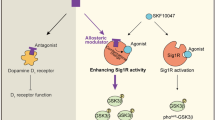Summary
Intraperitoneal injection of (+)-3-[3-hydroxyphenyl)-N-(1-propyl)piperidine ((+)-3PPP), a sigma receptor agonist, significantly reduced the striatal levels of dopamine (DA), 3,4-dihydroxyphenylacetic acid (DOPAC) and homovanillic acid (HVA) measured by in vivo microdialysis. These reductions were significantly greater at (+)-3PPP doses of 12 and 24 mg/kg than at 1 mg/ kg. The levels of 5-hydroxyindoleacetic acid (5HIAA) were increased by the injection of (+)-3PPP in dose of 24 mg/kg, but were not affected at lower doses. BMY-14802, a sigma antagonist, alone at doses of 15 mg/kg and 30 mg/kg did not affect the levels of DA, DOPAC, HVA and 5HIAA. Pretreatment with 30 mg/kg BMY-14802 reversed the reduction of the levels of DA induced by 12 mg/kg (+)-3PPP. Although neither 30 mg/kg BMY-14802 nor 12 mg/kg (+)-3PPP affected the levels of striatal 5HIAA, combined treatment with both produced a significant elevation. These findings clearly demonstrate that sigma receptors may regulate DA release from the striatal presynapse.
Similar content being viewed by others
References
Amt J, Bogeso KP, Christensen AV, Hyttel J, Larsen J-J, Svendsen O (1983) Dopamine receptor agonistic and antagonistic effects of 3-PPP enantiomers. Psychopharmacology 81: 199–207
Ceci A, Smith M, French ED (1988) Activation of A10 mesolimbic system by the σ-receptor agonist (+) SKF 10,047 can be blocked by rimcazole, a novel putative antipsychotic drug. Eur J Pharmacol 154: 53–57
De Costa BR, Bowen WD, Hellewell SB, Walker JM, Thurkauf A, Jacobson AE, Rice KC (1989) Synthesis and evaluation of optically pure [3H]-(+)-pentazocine, a highly potent and selective radioligand for a receptors. FEBS Lett 251: 53–58
Ferris RM, Harfenist M, McKenzie GM (1982) BW234U, (cis-9-[3-(3,5-dimethyl-l-piperazinyl)propyl]-carbazoledihydrochloride): a novel antipsychotic agent. J Pharm Pharmacol 34: 388–390
Graybiel AM, Besson M-J, Weber E (1989) Neuroleptic sensitive binding sites in the nigrostriatal system: evidence for differential distribution of sigma sites in the substantia nigra, pars compacta of the cat. J Neurosci 9: 326–338
Gundlach AL, Largent BL, Snyder SH (1986) Autoradiographic localization of sigma receptor binding sites in guinea pig and rat central nervous system with (+)-3H-3-(3-hydroxyphenyl)-N-(1-propyl)piperidine. J Neurosci 6: 1757–1770
Hjorth S, Carlsson A, Clark D, Svensson K, Wikstrom H, Sanchez D, Lindberg P, Hachsell U, Arvidsson L-E, Johansson A, Nilsson JLG (1983) Central dopamine receptor agonist and antagonist actions of enantiomers of 3-PPP. Psychopharmacology 81: 89–99
Imperato A, Tanda G, Frau R, Di Chiara G (1988) Pharmacological profile of dopamine receptor agonists as studied by brain dialysis in behaving rats. J Pharmacol Exp Ther 245: 257–264
Kanzaki A, Akiyama K, Otsuki S (1992) Subchronic methamphetamine treatment enhances ouabain-induced striatal dopamine efflux in vivo. Brain Res 569: 181–188
Koch SW, Koe BK, Bacopoulos NG (1983) Differential effects of the enantiomers of 3-(3-hydroxyphenyl)-N-n-propylpiperidine (3-PPP) at dopamine receptor sites. Eur J Pharmacol 92: 279–283
Largent BL, Gundlach AL, Snyder SH (1984) Psychotomimetic opiate receptors labeled and visualized with (+)-[3H]-3-[3-hydroxyphenyl]-N-(l-propyl)piperidine. Proc Natl Acad Sci USA 81: 4983–4987
Largent BL, Wikstrom H, Snowman AM, Snyder SH (1988) Novel antipsychotic drugs share high affinity for σ receptors. Eur J Pharmacol 155: 345–347
Martin WR, Eades CG, Thompson JA, Huppier RE, Gilbert PE (1976) The effects of morphine-like drugs in the nondependent and morphine-dependent chronic spinal dog. J Pharmacol Exp Ther 197: 517–532
Mikuni M, Gudelsky GA, Simonivic M, Meltzer HY (1984) Interaction of (+)- and (−)-3-PPP with the dopamine receptor in the anterior pituitary gland. Life Sci 34: 239–246
Mulder AH, Draper R, Smimia P, Schoffelmeer ANM, Stoof JC (1985) Agonist and antagonist effects of 3-PPP enantiomers on functional dopamine autoreceptors and presynaptic dopamine receptors in vitro. Eur J Pharmacol 107: 291–297
Steinfels GF, Tarn SW (1989) Selective σ receptor agonist and antagonist affect dopamine neuronal activity. Eur J Pharmacol 163: 167–170
Tam SW (1983) Naloxone-inaccessible a receptor in rat central nervous system. Proc Natl Acad Sci USA 80: 6703–6707
Taylor DP, Deklava J (1987) Potential antipsychotic BMY 14802 selectively binds to sigma sites. Drug Dev Res 11: 65–70
Taylor DP, Eison MS, Lobeck WG, Riblet LA, Temple DL, Yevich JP (1985) BMY 14802: a potential antipsychotic agent that dose not bind to D-2 dopamine sites. Soc Neurosci Abstr 11: 114
Ujike H, Okumura K, Zushi Y, Akiyama K, Otsuki S (1992) Persistent supersensitivity of sigma receptors develops during repeated methamphetamine treatment. Eur J Pharmacol 211: 323–328
Walker JM, Bowen WD, Walker FO, Matsumoto RR, de Costa B, Rice KC (1990) Sigma receptors: biology and function. Pharmacol Rev 42: 355–402
Weber EM, Sonders M, Quarum M, McLean S, Pou S, Keana JFW (1986) 1,3-Di(2-[5-3H]tolyl)guanidine: a selective ligand that labels sigma-type receptors for psychotomimetic opiates and antipsychotic drugs. Proc Natl Acad Sci USA 83: 8784–8788
Author information
Authors and Affiliations
Rights and permissions
About this article
Cite this article
Kanzaki, A., Okumura, K., Ujike, H. et al. BMY-14802 reverses the reduction of striatal dopamine release induced by (+)-3-[3-hydroxyphenyl]-N-(1-propyl)piperidine. J. Neural Transmission 90, 137–144 (1992). https://doi.org/10.1007/BF01250795
Received:
Accepted:
Issue Date:
DOI: https://doi.org/10.1007/BF01250795




